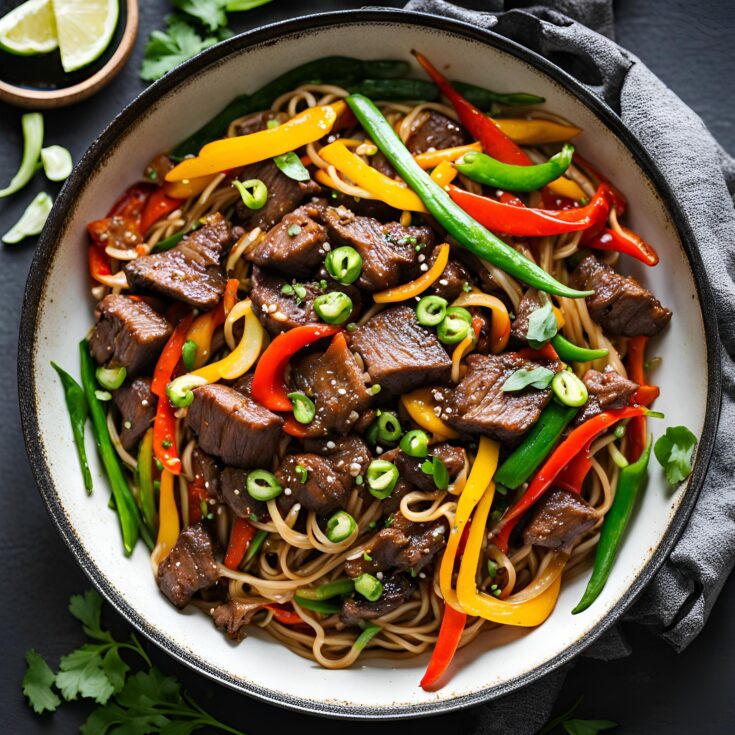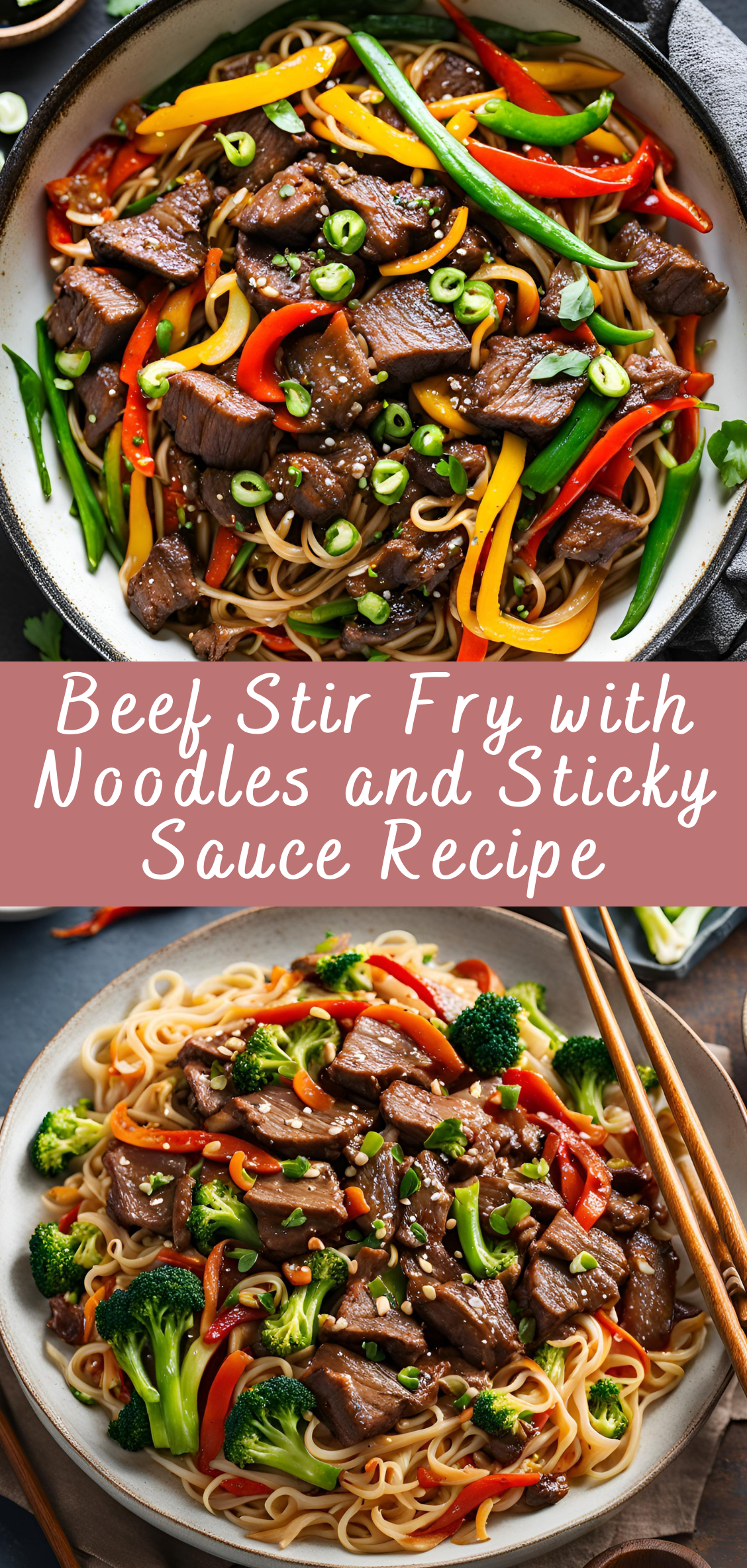Beef Stir Fry with Noodles and Sticky Sauce Recipe
Beef Stir Fry with Noodles and Sticky Sauce is a quintessential dish in many Asian-inspired kitchens. The combination of tender beef, fresh vegetables, and chewy noodles, all wrapped in a savory, slightly sweet, and sticky sauce, makes for a dish that is both comforting and satisfying. Whether served as a weeknight dinner or a special occasion meal, it’s a go-to recipe for anyone craving flavorful, homemade stir-fried food.

This dish draws inspiration from various Asian cuisines, particularly Chinese and Thai stir fry techniques, known for their quick cooking methods and vibrant flavors. The “sticky sauce” typically refers to a sauce that has a slightly thicker consistency, often made with ingredients like soy sauce, hoisin sauce, oyster sauce, or even a bit of cornstarch to help the sauce cling to the noodles and beef.
In this detailed recipe, we’ll guide you through all the necessary steps, ingredients, and tips to create a perfect Beef Stir Fry with Noodles and Sticky Sauce. From marinating the beef to achieving the right texture of noodles and the glossy, flavorful sauce, you’ll learn everything you need to create a fantastic stir fry that will rival any takeout.
Key Components of the Dish
This stir fry consists of several key elements:
- Beef: Thinly sliced beef (often flank steak or sirloin) provides the protein and adds richness to the dish. The beef should be marinated for flavor and tenderness.
- Noodles: The noodles serve as the base of the dish, soaking up the sauce and balancing the savory flavors of the beef and vegetables. Typically, egg noodles, rice noodles, or even udon noodles work well in this stir fry.
- Vegetables: A mix of colorful vegetables not only adds nutritional value but also provides a crisp texture to contrast with the tender beef and soft noodles. Common choices include bell peppers, carrots, onions, and snap peas.
- Sauce: The sticky sauce is what ties the dish together. A good stir fry sauce is balanced, with salty, sweet, and sometimes sour notes. Ingredients like soy sauce, hoisin, sesame oil, rice vinegar, and a touch of sugar come together to create a deliciously glossy, sticky coating.
- Aromatics: Garlic, ginger, and green onions are often used to add depth of flavor to the dish. Freshly minced garlic and grated ginger are fried in oil at the start of the cooking process to release their essential oils and create an aromatic base for the stir fry.
Preparation Steps
Step 1: Marinate the Beef
Begin by preparing the beef for stir frying. Slice the flank steak or sirloin thinly against the grain into 1/4-inch strips. This ensures the beef stays tender when cooked.
In a medium-sized bowl, combine the soy sauce, cornstarch, rice wine (or sherry), sesame oil, sugar, and white pepper. Add the sliced beef to the marinade and mix well to coat. Cover and let the beef marinate for at least 15-20 minutes. If you have more time, you can marinate it for up to 1 hour in the refrigerator for deeper flavor.
Step 2: Prepare the Noodles
If you’re using dry noodles, cook them according to the package instructions. Fresh noodles typically need less time—just blanch them in boiling water for 1-2 minutes until soft and al dente, then drain and set aside. Toss the noodles with a little sesame oil to prevent them from sticking together.
Step 3: Prepare the Vegetables
While the beef is marinating and the noodles are cooking, prep your vegetables. Slice the bell pepper, carrot, onion, and mushrooms. Trim the snap peas, and if using, slice them in half for easier cooking. Having everything prepped and ready to go will make stir-frying quicker and easier.
Step 4: Make the Sauce
In a small bowl, whisk together the soy sauce, hoisin sauce, oyster sauce (if using), rice vinegar, brown sugar, cornstarch, sesame oil, white pepper, and water (or broth). Stir well until the sugar is dissolved and the cornstarch is fully incorporated. Set the sauce aside.
Step 5: Stir Fry the Beef
Heat a large skillet or wok over medium-high heat and add 1 tablespoon of vegetable oil. Once the oil is hot but not smoking, add the marinated beef. Stir fry the beef in a single layer for 1-2 minutes without stirring, allowing it to sear. Then, stir fry for another 2-3 minutes until the beef is browned and cooked through. Remove the beef from the pan and set it aside.
Step 6: Stir Fry the Vegetables
In the same pan, add another tablespoon of vegetable oil. Add the garlic and ginger and stir fry for about 30 seconds until fragrant. Then, add the carrots, bell peppers, onions, snap peas, and mushrooms. Stir fry for about 3-5 minutes, or until the vegetables are tender-crisp but still vibrant in color.
Step 7: Combine Everything
Return the beef to the pan with the vegetables. Add the cooked noodles and pour in the prepared sauce. Toss everything together gently, making sure the noodles and beef are well coated with the sauce. Stir fry for another 2-3 minutes, allowing the sauce to thicken and become glossy, sticking to the beef and noodles.
Step 8: Garnish and Serve
Once everything is well combined and heated through, taste the dish and adjust the seasoning if needed. Garnish with chopped green onions and a sprinkle of toasted sesame seeds, if desired.
Serve immediately while the stir fry is hot. Enjoy!
Tips for the Perfect Beef Stir Fry
- Slice the Beef Thinly: For tender beef, it’s crucial to slice it thinly against the grain. This ensures the meat is easy to chew and cooks quickly.
- Use High Heat: Stir frying is best done over high heat. This helps to cook the ingredients quickly, retaining their color, texture, and flavor.
- Don’t Overcrowd the Pan: If you have a lot of ingredients, cook in batches. Overcrowding the pan will cause the ingredients to steam rather than stir fry.
- Adjust the Sauce to Your Taste: The beauty of stir fry sauces is their versatility. Adjust the sweetness, saltiness, or acidity to match your preferences. You can add more sugar for sweetness or more vinegar for acidity.
- Add Crunch with Fresh Herbs: For added freshness, top your stir fry with fresh cilantro or basil leaves. These herbs complement the rich, savory flavors and provide an extra layer of flavor.
- Use a Non-Stick Pan or Wok: A wok or a good-quality non-stick skillet will allow for the best stir fry experience, ensuring the ingredients are evenly cooked and that the sauce doesn’t stick too much to the pan.
- Feel Free to Add Other Vegetables: This recipe is flexible, so you can add other vegetables like broccoli, zucchini, baby corn, or bok choy. Just make sure to cut them into similar sizes to ensure even cooking.
- Customize the Protein: You can swap out beef for chicken, pork, shrimp, or even tofu for a different version of the dish. Just make sure to adjust the cooking times accordingly for different proteins.
Variations and Substitutions
- Vegetarian Version: Substitute the beef with tofu or tempeh. For tofu, press it to remove excess moisture before pan-frying or stir-frying it until crispy.
- Gluten-Free: Use tamari instead of soy sauce and gluten-free noodles to make this recipe gluten-free.
- Spicy Version: If you love heat, add more chili paste or fresh chopped chili peppers to the sauce.
- Additional Flavor Boosters: For extra flavor, try adding a bit of five-spice powder, star anise, or Chinese cooking wine to the marinade or sauce.
Conclusion
Beef Stir Fry with Noodles and Sticky Sauce is a flexible and delicious recipe that can easily be customized to suit different tastes and dietary needs. By following this step-by-step guide, you can create a restaurant-quality dish at home. Whether you’re craving something sweet, savory, or spicy, this stir fry will satisfy your appetite with its balanced flavors, tender beef, and perfectly cooked noodles. With a little practice, you’ll be able to whip up this dish in no time, making it a staple in your weeknight dinner rotation!
The Importance of Timing in Stir Fry
Stir frying is all about speed, heat, and technique. The key to a perfect stir fry is cooking each ingredient at the right moment and ensuring that everything is perfectly cooked without becoming overdone. Here’s a more detailed breakdown of the timing and steps involved:
- Prep Ingredients Before Cooking: Stir frying requires precision and quick movements. To avoid burning or overcooking, prepare all ingredients ahead of time. This includes slicing the beef, chopping vegetables, and mixing the sauce. Having everything ready and within reach before turning on the stove is crucial. This process is called mise en place, which means “everything in its place.”
- Preheat the Pan or Wok Properly: A wok or large skillet should be heated until it’s just about smoking, and only then should you add oil. This ensures that the meat sears immediately, locking in its juices, and that the vegetables remain crispy.
- Cook Protein First: Whether you’re using beef, chicken, shrimp, or tofu, protein should always be cooked first. This allows the meat to release its juices and develop a nice sear. After removing the protein from the pan, you’ll use the same pan to stir-fry the vegetables, infusing them with the residual flavors from the meat.
- Vegetables Follow: Vegetables, especially harder ones like carrots and bell peppers, should be added first. Softer vegetables like mushrooms or leafy greens are added later so they don’t lose their texture. The general rule is to cook the firmer vegetables for a few minutes before adding the more delicate ones.
- Noodles Last: Add the noodles near the end. Since they are already cooked or just need to be heated through, they’ll soak up the sauce and flavors without overcooking.
- Don’t Overcrowd the Pan: If you find yourself cooking for a crowd or making a large batch, consider cooking in batches. Overcrowding the pan leads to steaming rather than stir frying, which can cause the ingredients to lose their crispness.
Cooking Techniques for the Perfect Beef Stir Fry
To create the best beef stir fry with noodles, it’s important to master a few core cooking techniques that are essential in Asian stir-frying. These techniques ensure that your stir fry is flavorful, evenly cooked, and visually appealing.
1. Velveting the Beef
Velveting is a technique where meat is coated in a cornstarch mixture and briefly fried or blanched before stir-frying. This helps the beef retain moisture and tenderness during cooking. Here’s how you can velvet the beef:
- Mix cornstarch, a little egg white, and some rice wine or soy sauce.
- Coat the thinly sliced beef in this mixture and let it sit for about 15-20 minutes.
- When you stir fry, you’ll notice the beef has a smoother, velvety texture, which is a hallmark of many Chinese-style stir-fries.
This method not only makes the beef tender but also helps the sauce adhere better to the protein.
2. High Heat for Quick Cooking
The hallmark of stir-frying is high heat. When you cook on high heat, the ingredients cook quickly and evenly without stewing in their own moisture. This creates the signature crisp texture in the vegetables and allows the beef to sear rather than stew. If you’re using a wok, make sure it’s preheated and ready before adding oil. A wok has high sides, so you can stir and toss the ingredients easily without worrying about spills.
3. Tossing the Ingredients
To get a uniform cook, you’ll want to toss the ingredients in the pan using a quick and consistent motion. This is often done by holding the handles of the wok or skillet and shaking the pan while using a spatula to keep everything moving. Tossing ensures that all sides of the meat and vegetables are exposed to the heat, resulting in even cooking.
Ingredient Substitutions and Variations
One of the great things about stir fry is that it’s incredibly adaptable. You can swap out or add ingredients based on personal taste or what you have on hand. Here are some potential substitutions or additions you can explore:
1. Meat Substitutes
- Chicken: Thinly sliced chicken breast or thigh is a great substitute for beef. Chicken thighs will offer a juicier, more flavorful alternative.
- Pork: Pork tenderloin or shoulder can also be used in place of beef. Make sure to slice it thinly for tenderness.
- Shrimp: If you want to add seafood to the mix, shrimp works wonderfully in stir-fries. Stir fry shrimp for only 2-3 minutes, as they cook quickly.
- Tofu/Tempeh: For a vegetarian or vegan option, tofu or tempeh works excellently. For crispy tofu, use extra-firm tofu and press out the moisture before stir-frying.
- Beef Alternatives: For those following a plant-based diet, you can try plant-based beef substitutes like Beyond Beef or Impossible Meat. These work similarly to traditional beef but are made from plants.
2. Vegetable Variations
If you want to add variety to your vegetable mix, here are some other veggies that pair well with stir fry:
- Bok Choy: A popular Asian green that adds a mild flavor and satisfying crunch.
- Broccoli: Broccoli florets hold up well in stir fries, adding texture and nutrients.
- Baby Corn: These sweet and crunchy pieces are often found in stir-fries and add visual appeal.
- Zucchini: Zucchini has a soft texture when cooked but still provides a good contrast to the meat.
- Snow Peas: Slightly sweeter and crunchier than snap peas, snow peas can also be used in place of snap peas.
3. Noodle Choices
- Rice Noodles: Rice noodles are a gluten-free alternative and work well in stir fry, absorbing the sauce beautifully.
- Egg Noodles: The most common noodle used in stir fry, egg noodles have a rich, chewy texture that pairs perfectly with the sticky sauce.
- Udon Noodles: These thick, chewy Japanese noodles add a hearty feel to the dish.
- Soba Noodles: For a healthier option, try buckwheat soba noodles. These have a distinct flavor and are great in stir fries.
How to Serve Your Beef Stir Fry
Presentation is an important part of the dining experience, and your beef stir fry can be just as impressive to the eyes as it is to the taste buds.
1. Use a Large Platter or Bowl
For a more rustic and family-style presentation, serve your stir fry in a large shallow platter or a deep serving bowl. This allows your guests to help themselves and adds a sense of sharing to the meal.
2. Garnish with Fresh Herbs and Seeds
Once plated, garnish your stir fry with finely chopped green onions, fresh cilantro, or basil leaves. A sprinkling of toasted sesame seeds also adds texture and visual appeal. If you prefer a spicier garnish, drizzle some chili oil or sprinkle red pepper flakes for an extra kick.
3. Pair with Side Dishes
Beef stir fry with noodles is already quite filling, but if you want to add more variety, consider pairing it with:
- Steamed Jasmine Rice: The fragrance of jasmine rice complements the rich flavors of the stir fry.
- Egg Rolls: Crispy, fried egg rolls with a savory filling work as a perfect appetizer.
- Soup: A light miso or vegetable soup could be served as a starter to balance the richness of the stir fry.
4. Serve with Tea or Wine
For a drink pairing, a chilled white wine like Sauvignon Blanc or a light Riesling pairs wonderfully with the stir fry’s savory-sweet profile. If you prefer something non-alcoholic, green tea or jasmine tea works well to cleanse the palate between bites.
Troubleshooting and Common Mistakes
Even the best cooks can encounter challenges when stir frying. Here are some common issues you might face and tips for troubleshooting them:
- The Sauce Is Too Watery: If your sauce is too thin, mix a little extra cornstarch with water to form a slurry and add it to the stir fry. This will help thicken the sauce.
- The Beef Is Tough: If the beef becomes tough, it might be due to overcooking. Stir fry the beef on high heat for a short amount of time to retain tenderness. Also, be sure to slice against the grain.
- Vegetables Are Overcooked: Vegetables can lose their color and texture if cooked too long. Make sure to stir-fry on high heat for a short time and don’t overcrowd the pan.
- The Noodles Are Sticking Together: If your noodles are sticking together after cooking, rinse them briefly with cold water to separate them, and then toss them with a small amount of sesame oil to prevent sticking.
Conclusion: Becoming a Stir Fry Master
With the right techniques and ingredients, Beef Stir Fry with Noodles and Sticky Sauce can be a dish that you perfect over time and make your own. Whether you’re cooking for one, two, or a whole family, this recipe can easily be scaled up or down.
Beef Stir Fry with Noodles and Sticky Sauce Recipe

Beef Stir Fry with Noodles and Sticky Sauce is a quintessential dish in many Asian-inspired kitchens. The combination of tender beef, fresh vegetables, and chewy noodles, all wrapped in a savory, slightly sweet, and sticky sauce, makes for a dish that is both comforting and satisfying. Whether served as a weeknight dinner or a special occasion meal, it’s a go-to recipe for anyone craving flavorful, homemade stir-fried food.
Ingredients
- For the Stir Fry:
- 1 lb (450g) beef (sirloin, flank steak, or ribeye), thinly sliced against the grain
- 8 oz (225g) noodles (egg noodles, rice noodles, or any choice)
- 2 tbsp vegetable oil (for stir-frying)
- 1 red bell pepper, thinly sliced
- 1 small onion, thinly sliced
- 1 medium carrot, julienned
- 1 cup broccoli florets
- 2 cloves garlic, minced
- 1-inch piece of ginger, grated
- 2 green onions, sliced (for garnish)
- For the Sticky Sauce:
- 3 tbsp soy sauce (low-sodium recommended)
- 2 tbsp hoisin sauce
- 1 tbsp oyster sauce
- 1 tbsp dark brown sugar
- 1 tbsp rice vinegar
- 1 tbsp cornstarch (mixed with 2 tbsp water to make a slurry)
- 1 tsp sesame oil
- 1/2 tsp chili flakes (optional for heat)
Instructions
- Prepare the Noodles:Cook noodles according to package instructions, then drain and set aside.
- Make the Sauce:In a small bowl, combine the soy sauce, hoisin sauce, oyster sauce, brown sugar, rice vinegar, sesame oil, and chili flakes. Stir to combine. In a separate small bowl, mix cornstarch with 2 tbsp water to create a slurry. Add the slurry to the sauce mixture and stir until smooth. Set aside.
- Stir-fry the Beef:Heat 1 tablespoon of vegetable oil in a large skillet or wok over medium-high heat. Once hot, add the sliced beef in a single layer. Let it sear without stirring for about 2-3 minutes. Flip and cook for another 1-2 minutes until browned and cooked through. Remove the beef from the skillet and set aside.
- Stir-fry the Vegetables:In the same skillet, add another tablespoon of oil. Add the garlic and ginger, cooking for 30 seconds until fragrant. Add the red bell pepper, onion, carrot, and broccoli. Stir-fry for about 3-4 minutes until the vegetables are tender-crisp.
- Combine Beef, Vegetables, and Sauce:Return the cooked beef to the skillet. Pour the sticky sauce over the beef and vegetables. Stir well to coat everything in the sauce. Let the sauce simmer for 2-3 minutes until thickened.
- Add Noodles:Add the cooked noodles to the skillet and toss everything together until the noodles are evenly coated with the sauce and heated through.
- Garnish and Serve:Garnish with sliced green onions and serve immediately.



